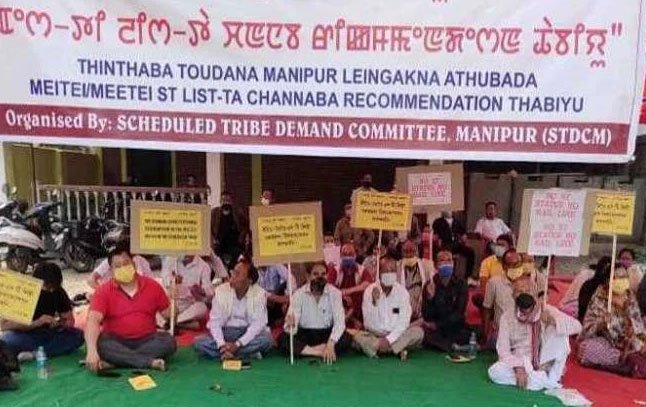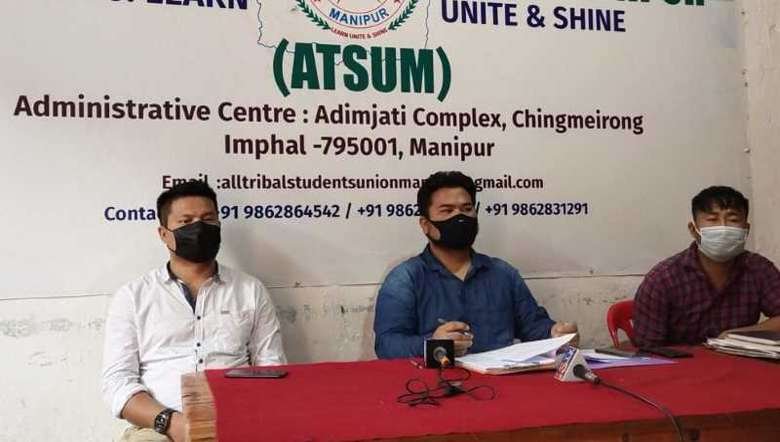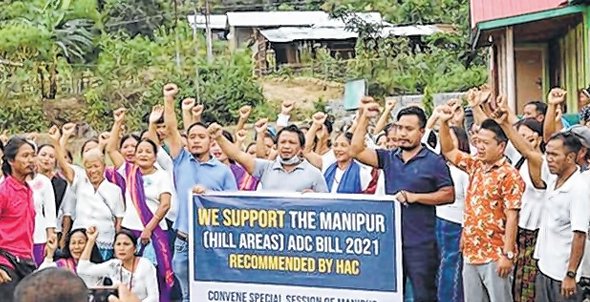IMPHAL, Oct 23: As the movement of the Scheduled Tribe Demand Committee, Manipur (STDCM) demanding the inclusion of Meitei/Meetei community in the ST list of India gaining momentum, the All Tribal Students’ Union, Manipur (ATSUM) has urged the Hill Areas Committee (HAC) to peruse over the situation and intervene accordingly.
In a memorandum submitted recently to Dinganglung Gangmei, chairman of the HAC, the apex tribal student body of Manipur said, “In the event of the demand for inclusion of Meitei/Meetei Community in the ST category gaining momentum with most of the legislators from the valley including the MP (Rajya Sabha) openly declaring their support without taking into account the irrationality of the demand and sentiments of the tribal community of the State, the All Tribal Students’ Union Manipur (ATSUM) is constrained to submit this representation as a reminder for utmost perusal and intervention as the future of the tribal communities looks bleak and uncertain”.
Time and again, the ATSUM ‘unequivocally’ expressed its stated position on this contested demand of the “majority community as it posed serious threat to the land and existence of tribal people with the empirical reasoning that the Meeteis/Meiteis are an advanced community marked by 2000 years of civilisation, unbroken lineage of kingship, superlative cultural advancement with its exquisite classical dances purportedly shown as the finest form of arts, Meitei Language (Manipuri) recognised under the Eight Schedule of the Indian Constitution, urban civilisation for eons, participation and signing of international treaties with the British in 1762 AD and 1826 AD, academic advancement with high literacy rate”.
The ATSUM memorandum also said, “The fact that the Meetei/Meitei community has done exceedingly well in the fields of technology, medical, engineering, sports and of late civil services under UPSC is indicative of their advancement”. For instances, according to the ATSUM, 15 students from the community cracked the NDA examination last year, two civil service this year and the bulk of MBBS successful students in the whole North-Eastern States came from the Meetei/Meitei community.
According to the ATSUM, it is a well known fact that the Meitei/Meetei community, the majority community in the State of Manipur, categorised as General, Scheduled Caste and Other Backward Classes is excelling and commanding in all aspects of life. The ATSUM then alleged that despite being already categorised as SC and OBC, the same Meitei/Meetei community is propelling an intrusive agenda for inclusion in ST category with a sole objective of grasping the benefits accompanying the status.
The tribal student organisation then pointed out that the entry of the Meena community of Rajasthan into the ST category in the year 2008 has seriously dented the prospect of the other aspirants from the tribal community of India within the purview of UPSC, SSC and other equivalent examinations under the Government of India with them reaping the maximum benefits and the others in trickles. “And if the Meetei/Meitei community which is far advanced than the Meena community is incorporated, it will definitely spell a collective doom for the whole tribal community of India and Manipur in particular,” it added.
The ATSUM then said that it is duty bound to share its shared opinion and displeasure over the ill-conceived demand of the STDCM for recognition of ST to the Meeteis who have been living at par with the rest of the privileged section of societies in all spheres of lives for the past seventy-five years of Independence. The ATSUM further said that the ‘illogical claim’ that the Meiteis fulfilled all the criterion to become and Scheduled Tribe on the basis of Mongoloid race and prevalence of distinctive religion and culture is irrational on the ground that any community big or small practices some form of religion and possesses a unique culture of their own. “In other words, having religion or separate culture doesn’t necessarily mean or constitute the prime reason to include a particular community to be in the list of Scheduled Tribe,” it also said. In the Constitution of India, no criteria have been spelt out for specification of a community as a Scheduled Tribe, the ATSUM added. “As however, taking into account the definitions in a 1931 census and the reports of the First Backward Classes commission 1955, the advisory committee on revision of ST/SC 1967 and basically basing on Article 342 of the constitution, the following criteria are followed for specification of a community as a schedule tribe: a) Indication of primitive traits, (b) Distinctive culture, (c) Geographical isolation, (d) Shyness of contact with community at large, and (e) Backwardness.
According to the ATSUM, it is quite obvious that the plain people viz. Meeteis/Meitei were included in the general category of the people by the Central Government due to the simple fact that the Meiteis have superseded the component characteristic of a tribe. In the course of a continuous process of civilisation for over a period of 2,000 years dating back from 33 AD, the Meeteis have abandoned/discarded their primitive culture traits from being tribal to general, from rural or urbanisation, economic backwardness to economically advance people in the valley of the golden kingdom (Sana Konung), the ATSUM further stated.
“The criterion of backwardness does remain as the main criterion. The relative backwardness of a community as compared to the society at large and other communities in the areas has therefore to be judged. Such data should inter-alia include the data on the representation of the community in the Government/public sectors services, political institutions like parliament, State Assemblies and local bodies,” it added.
Lastly, the ATSUM stated that the social divide between the people of the hills and valley and the derogatory name given to the tribal of Manipur by the Meeteis as ‘Haos’ besides social segregation as untouchables to the hill men/tribal is an established fact that the Meeteis have crossed several phase of civilisation to the mainstream of modernity. “Since time immemorial, the hills – valley divide has been a major theme in understanding the ethnic relations in India’s North Eastern State of Manipur,” the tribal student body also said. (NNN)







